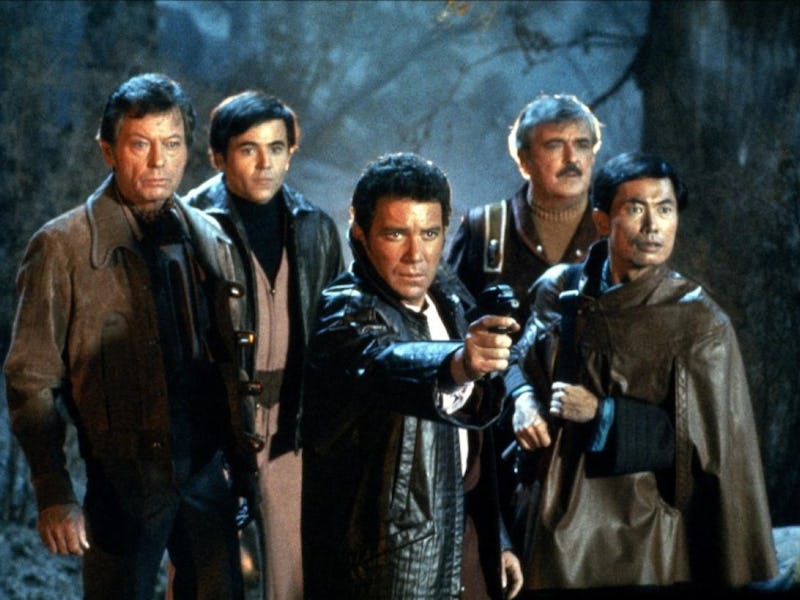Star Trek’s Most Infamous Retcon Looks Quaint Today
Don’t worry, Spock was only mostly dead.

When Paramount greenlit a third Star Trek film the day after the second one opened in 1982, there was really only one goal: bring back Spock, whose noble sacrifice at the end of The Wrath of Khan sent shockwaves throughout pop culture. It was an audacious and emotional demise that fit perfectly with the operatic melodrama of Nicholas Meyer’s film. In fact, it was so dramatic, it felt incomplete without Spock’s grieving friends carrying out a daring, Federation-defying, friendship-first mission to take advantage of cosmic convolutions and resurrect him.
Spock’s blend of calming reason and alien strangeness defined Star Trek more than any captain; he sees the galaxy differently than his crewmates, both with scientific acumen and a curiosity about his own imaginative inabilities. The character was carefully balanced by placing contrasting personalities around him, so it’s fitting that his absence in 1984’s The Search for Spock, directed by Leonard Nimoy, feels like a loss of galactic proportions.
Kirk (William Shatner) and the crew of a battered Enterprise arrive at Spacedock in mourning, and it’s not long before Spock’s father, Sarek (Mark Lenard), confronts Kirk over his decision to jettison Spock’s body onto Wrath’s newly formed Genesis planet. He tells Kirk that Spock’s “katra,” in effect his spirit, needs to be laid to rest with his body back on Vulcan, and they both learn that Spock transferred his katra to Dr. McCoy (DeForest Kelley), which explains why Bones keeps breaking out in an eerie Leonard Nimoy impression for most of the film.
Admiral Morrow (Robert Hooks) won’t let Kirk return to Genesis, so Kirk and his crew steal the Enterprise for an unsanctioned mission to honor their truest friend while trying to avoid the Klingon Bird of Prey hunting down Genesis’ secrets. While it’s named after Spock, this is as pure a Kirk film as we ever got, and the conviction and charm that Shatner channels in every scene makes him a winning hero to root for. “Kirk, you do this, and you’ll never sit in the captain’s chair again,” Morrow warns seconds before the Enterprise jets off, and Shatner’s face shows how much this warning steels Kirk’s resolve to buck authority and save his comrade.
For all its heart-on-sleeve, swashbuckling emotions, The Search for Spock had a tepid reception, and amid the original run of Trek movies, even the reappraisal of Robert Wise’s The Motion Picture feels more full-bodied. The effects are creaky, the stakes less gripping, and the film turns to sentiment and spirituality with such zeal that it’s jarring to watch Vulcan mysticism win the day. But most egregiously, The Search for Spock revolves around a massive retcon of the bold move the series had just made.
But retcons mean something different today than they did in 1984, and there are many reasons why Search for Spock feels clean-cut and contained compared to other canon kerfuffles. Back then, there was only one Star Trek timeline and one batch of characters moving through the galaxy in a strictly linear fashion. There were no overlapping continuities like we’d see in the ’90s, where events from The Next Generation should have (but didn’t) impact Deep Space Nine, and continuity errors began to creep in.
Unlike The Search for Spock, which only introduced fashion errors.
In addition, Spock’s resurrection, achieved by a Vulcan ritual to meld his Genesis-reanimated body with his Bones-inhabiting katra, only has repercussions for Spock. The convoluted process can’t be replicated for anyone else on death’s door. It’s a far neater change than hoping audiences will quietly forget that warp speed is destroying the fabric of space.
The severity of any retcon is tied to the scope and function of a franchise. Trek continuity is now considered valuable to executives, and while the series has always deified its old stories and characters, today’s motive to protect canon feels more cynical. Like an antique sports car, classic Trek must remain untouched to maintain its financial value. The introduction of the alternate Kelvin Timeline in Star Trek, the 2009 reboot movie, felt like an attempt to give the new cast a chance out of the original’s spotlight, but it just affirmed the idea that The Original Series had to be honored, never challenged.
A franchise is easier to sell if it has a strict sense of cohesion and uniformity, and Search for Spock reminds us of a simpler relationship between creatives and audiences. It’s a wish-fulfillment exercise that centers the deep social bonds between the Enterprise crew that now supersedes their Starfleet duty, as they risk just as much as Spock did in trying to bring him back. There’s a rich romanticism that outshines any misgivings about the impermanence of dramatic storytelling choices. The Search for Spock excels not because it says Spock cannot die, but that Star Trek’s characters wouldn’t let him.